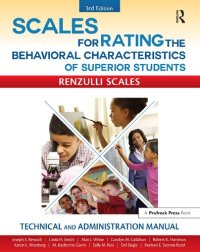
Ebook: Scales for Rating the Behavioral Characteristics of Superior Students: Technical and Administration Manual
Author: Joseph S Renzulli
This is the Technical and Administration Manual for the Scales for Rating the Behavioral Characteristics of Superior Students.
The Scales for Rating the Behavioral Characteristics of Superior Students are commonly referred to as the
- Renzulli Scales or
- Renzulli-Hartman Scales.
Now in its third edition, the Renzulli Scales are the nation's most popular tool for identifying gifted children. Supported by 40 years of research, the Renzulli Scales are used by gifted and talented programs across the country. This standardized instrument is completed by teachers and provides an effective method for identifying gifted children.
The Scales for Rating the Behavioral Characteristics of Superior Students: Technical and Administration Manual includes technical information about how the scales were developed as well as guidelines for using the scales. The manual includes a review of the supporting research for the instrument, field test data, and construct validity support. The manual also includes in-depth information about administering the Renzulli Scales and interpreting the results.
The manual features extensive appendices that include reproducible teacher training activities to help teachers understand how to use the scales and rate students, easy-to-follow instructions on how to establish local norms in a school or district, and a practical plan for identifying students for gifted and talented programs.
The Renzulli Scales are designed to obtain teacher estimates of a student's characteristics in the following areas:
Learning Characteristics
Creativity Characteristics
Motivation Characteristics
Leadership Characteristics
Artistic Characteristics
Musical Characteristics
Dramatics Characteristics
Communication Characteristics (Precision)
Communication Characteristics (Expressiveness)
Planning Characteristics
Mathematics Characteristics
Reading Characteristics
Technology Characteristics
Science Characteristics
Each scale contains multiple items that are rated using a Likert-type scale. The first four scales (learning, creativity, motivation, and leadership) are used by most schools that use the Scales. The remaining 10 scales are focused on specific areas. They are used by schools when those areas seem appropriate for a gifted program's goals. For example, a program serving gifted math students would use the mathematics scale, a science academy would use the science scale, etc.
Research shows that gifted children tend to exhibit certain observable behaviors, such as using advanced vocabulary, grasping underlying principles, and making generalizations from complex information. The Renzulli Scales asks teachers to rate children in comparison to their peers on a host of these observable behaviors. The children who score high on the scales are more likely to be gifted. Using a tool like the Scales, a school can narrow the number of students who will be fully evaluated for a gifted program.
The items were chosen from a comprehensive body of research concerning the characteristics of gifted students. Based on a multiple talent approach to the identification of gifted students, the scales help identify student strengths.
The Scales for Rating the Behavioral Characteristics of Superior Students are commonly referred to as the
- Renzulli Scales or
- Renzulli-Hartman Scales.
Now in its third edition, the Renzulli Scales are the nation's most popular tool for identifying gifted children. Supported by 40 years of research, the Renzulli Scales are used by gifted and talented programs across the country. This standardized instrument is completed by teachers and provides an effective method for identifying gifted children.
The Scales for Rating the Behavioral Characteristics of Superior Students: Technical and Administration Manual includes technical information about how the scales were developed as well as guidelines for using the scales. The manual includes a review of the supporting research for the instrument, field test data, and construct validity support. The manual also includes in-depth information about administering the Renzulli Scales and interpreting the results.
The manual features extensive appendices that include reproducible teacher training activities to help teachers understand how to use the scales and rate students, easy-to-follow instructions on how to establish local norms in a school or district, and a practical plan for identifying students for gifted and talented programs.
The Renzulli Scales are designed to obtain teacher estimates of a student's characteristics in the following areas:
Learning Characteristics
Creativity Characteristics
Motivation Characteristics
Leadership Characteristics
Artistic Characteristics
Musical Characteristics
Dramatics Characteristics
Communication Characteristics (Precision)
Communication Characteristics (Expressiveness)
Planning Characteristics
Mathematics Characteristics
Reading Characteristics
Technology Characteristics
Science Characteristics
Each scale contains multiple items that are rated using a Likert-type scale. The first four scales (learning, creativity, motivation, and leadership) are used by most schools that use the Scales. The remaining 10 scales are focused on specific areas. They are used by schools when those areas seem appropriate for a gifted program's goals. For example, a program serving gifted math students would use the mathematics scale, a science academy would use the science scale, etc.
Research shows that gifted children tend to exhibit certain observable behaviors, such as using advanced vocabulary, grasping underlying principles, and making generalizations from complex information. The Renzulli Scales asks teachers to rate children in comparison to their peers on a host of these observable behaviors. The children who score high on the scales are more likely to be gifted. Using a tool like the Scales, a school can narrow the number of students who will be fully evaluated for a gifted program.
The items were chosen from a comprehensive body of research concerning the characteristics of gifted students. Based on a multiple talent approach to the identification of gifted students, the scales help identify student strengths.
Download the book Scales for Rating the Behavioral Characteristics of Superior Students: Technical and Administration Manual for free or read online
Continue reading on any device:

Last viewed books
Related books
{related-news}
Comments (0)